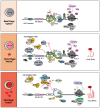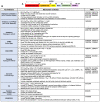Forging a Functional Cure for HIV: Transcription Regulators and Inhibitors
- PMID: 36146786
- PMCID: PMC9502519
- DOI: 10.3390/v14091980
Forging a Functional Cure for HIV: Transcription Regulators and Inhibitors
Abstract
Current antiretroviral therapy (ART) increases the survival of HIV-infected individuals, yet it is not curative. The major barrier to finding a definitive cure for HIV is our inability to identify and eliminate long-lived cells containing the dormant provirus, termed viral reservoir. When ART is interrupted, the viral reservoir ensures heterogenous and stochastic HIV viral gene expression, which can reseed infection back to pre-ART levels. While strategies to permanently eradicate the virus have not yet provided significant success, recent work has focused on the management of this residual viral reservoir to effectively limit comorbidities associated with the ongoing viral transcription still observed during suppressive ART, as well as limit the need for daily ART. Our group has been at the forefront of exploring the viability of the block-and-lock remission approach, focused on the long-lasting epigenetic block of viral transcription such that without daily ART, there is no risk of viral rebound, transmission, or progression to AIDS. Numerous studies have reported inhibitors of both viral and host factors required for HIV transcriptional activation. Here, we highlight and review some of the latest HIV transcriptional inhibitor discoveries that may be leveraged for the clinical exploration of block-and-lock and revolutionize the way we treat HIV infections.
Keywords: HIV; block-and-lock; epigenetic modulation; functional cure; inhibitors; latency; transcription.
Conflict of interest statement
The authors declare that they have no conflict of interest.
Figures
Similar articles
-
Structured treatment interruptions (STI) in chronic unsuppressed HIV infection in adults.Cochrane Database Syst Rev. 2006 Jul 19;2006(3):CD006148. doi: 10.1002/14651858.CD006148. Cochrane Database Syst Rev. 2006. PMID: 16856117 Free PMC article.
-
Interventions during Early Infection: Opening a Window for an HIV Cure?Viruses. 2024 Oct 9;16(10):1588. doi: 10.3390/v16101588. Viruses. 2024. PMID: 39459922 Free PMC article. Review.
-
The Black Book of Psychotropic Dosing and Monitoring.Psychopharmacol Bull. 2024 Jul 8;54(3):8-59. Psychopharmacol Bull. 2024. PMID: 38993656 Free PMC article. Review.
-
Efavirenz or nevirapine in three-drug combination therapy with two nucleoside or nucleotide-reverse transcriptase inhibitors for initial treatment of HIV infection in antiretroviral-naïve individuals.Cochrane Database Syst Rev. 2016 Dec 10;12(12):CD004246. doi: 10.1002/14651858.CD004246.pub4. Cochrane Database Syst Rev. 2016. PMID: 27943261 Free PMC article.
-
Antihelminthics in helminth-endemic areas: effects on HIV disease progression.Cochrane Database Syst Rev. 2016 Apr 14;4(4):CD006419. doi: 10.1002/14651858.CD006419.pub4. Cochrane Database Syst Rev. 2016. PMID: 27075622 Free PMC article.
Cited by
-
Silencing the transcriptionally active HIV reservoir to improve treatment outcomes.Nat Microbiol. 2024 Oct;9(10):2470-2472. doi: 10.1038/s41564-024-01816-5. Nat Microbiol. 2024. PMID: 39289508 Free PMC article.
-
CBP/p300 lysine acetyltransferases inhibit HIV-1 expression in latently infected T cells.iScience. 2024 Oct 28;27(12):111244. doi: 10.1016/j.isci.2024.111244. eCollection 2024 Dec 20. iScience. 2024. PMID: 39640574 Free PMC article.
-
HIV-1 Remission: Accelerating the Path to Permanent HIV-1 Silencing.Viruses. 2023 Oct 28;15(11):2171. doi: 10.3390/v15112171. Viruses. 2023. PMID: 38005849 Free PMC article.
-
Pharmacological Inhibition of IKK to Tackle Latency and Hyperinflammation in Chronic HIV-1 Infection.Int J Mol Sci. 2022 Nov 30;23(23):15000. doi: 10.3390/ijms232315000. Int J Mol Sci. 2022. PMID: 36499329 Free PMC article.
-
Identification of aryl hydrocarbon receptor as a barrier to HIV-1 infection and outgrowth in CD4+ T cells.Cell Rep. 2023 Jun 27;42(6):112634. doi: 10.1016/j.celrep.2023.112634. Epub 2023 Jun 12. Cell Rep. 2023. PMID: 37310858 Free PMC article.
References
-
- Marconi V.C., Moser C., Gavegnano C., Deeks S.G., Lederman M.M., Overton E.T., Tsibris A., Hunt P.W., Kantor A., Sekaly R.P., et al. Randomized Trial of Ruxolitinib in Antiretroviral-Treated Adults with Human Immunodeficiency Virus. Clin. Infect. Dis. 2022;74:95–104. doi: 10.1093/cid/ciab212. - DOI - PMC - PubMed
-
- Llibre J.M., Hung C.C., Brinson C., Castelli F., Girard P.M., Kahl L.P., Blair E.A., Angelis K., Wynne B., Vandermeulen K., et al. Efficacy, safety, and tolerability of dolutegravir-rilpivirine for the maintenance of virological suppression in adults with HIV-1: Phase 3, randomised, non-inferiority SWORD-1 and SWORD-2 studies. Lancet. 2018;391:839–849. doi: 10.1016/S0140-6736(17)33095-7. - DOI - PubMed
-
- Gupta R.K., Peppa D., Hill A.L., Gálvez C., Salgado M., Pace M., McCoy L.E., Griffith S.A., Thornhill J., Alrubayyi A., et al. Evidence for HIV-1 cure after CCR5Δ32/Δ32 allogeneic haemopoietic stem-cell transplantation 30 months post analytical treatment interruption: A case report. Lancet HIV. 2020;7:e340–e347. doi: 10.1016/S2352-3018(20)30069-2. - DOI - PMC - PubMed
Publication types
MeSH terms
Substances
Grants and funding
- R01 AI097012/AI/NIAID NIH HHS/United States
- UM1 AI164559/AI/NIAID NIH HHS/United States
- R33 AI140439/AI/NIAID NIH HHS/United States
- R01AI097012/AI/NIAID NIH HHS/United States
- R33AI140439-04/AI/NIAID NIH HHS/United States
- R01AI165137-01A1/AI/NIAID NIH HHS/United States
- R37 AI165137/AI/NIAID NIH HHS/United States
- R21AI158296-01A1/AI/NIAID NIH HHS/United States
- R01AI167732-01/AI/NIAID NIH HHS/United States
- R21 AI158296/AI/NIAID NIH HHS/United States
- R01 AI165137/AI/NIAID NIH HHS/United States
- R01 AI167732/AI/NIAID NIH HHS/United States
- UM1AI164559-01/AI/NIAID NIH HHS/United States
- U19 AI096113/AI/NIAID NIH HHS/United States
LinkOut - more resources
Full Text Sources
Medical



